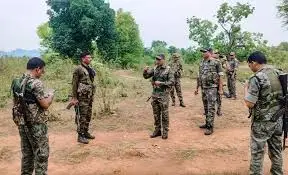Maoist with Rs 5 lakh bounty killed in gunfight in Jharkhand’s Latehar

In a significant operation, security forces killed a Maoist commander carrying a Rs 5 lakh bounty in a gunfight in Jharkhand’s Latehar district. This marks a key victory in the ongoing battle against Maoist insurgents in the region.
The Encounter: Key Details
Late Sunday night, security personnel launched a planned operation in the dense Dauna forest area under Mauhadand police station limits. Acting on reliable intelligence, they targeted Manish Yadav, a top Maoist leader.
A fierce gun battle broke out between the Maoists and the forces. Despite the strong resistance, the security team killed Manish Yadav. Known for leading violent attacks on government officials and security personnel, Yadav posed a serious threat for years. The Rs 5 lakh bounty on him underscored his importance to the Maoist network.
During the same operation, security forces arrested another Maoist, Kundan Kherwar. His capture is expected to provide valuable intelligence for future actions.
Maoist Insurgency in Jharkhand: A Brief Overview
Jharkhand has suffered from Maoist violence for decades. The insurgents, also called Naxals, operate mainly in forested and tribal regions. They combine a radical ideology with local grievances over land rights and neglect.
The Maoists regularly target security forces, government infrastructure, and local administration. Their aim is to weaken the state’s control and promote their revolutionary agenda.
To fight this, the government has stepped up security deployments, enhanced intelligence efforts, and launched development programs in affected areas.
Recent Successes Against Maoists
This encounter follows another major success. On Saturday, security forces killed two leaders of the Jharkhand Jan Mukti Parishad (JJMP), a Maoist splinter group, in Ichabar area of Latehar.
Pappu Lohra, JJMP chief, had a Rs 10 lakh bounty, and his deputy Prabhat Ganjhu carried a Rs 5 lakh reward. Both died in the gunfight, severely weakening the splinter group.
These actions show a coordinated approach targeting both main Maoist factions and their splinter groups simultaneously. This strategy aims to prevent regrouping and reduce insurgent violence.
Impact on Maoist Groups
Police officials say these operations have critically weakened Maoist groups in Jharkhand. Many factions now lack clear leadership and face disorganization.
Deputy Inspector General Y.S. Ramesh stated that security forces have eliminated or arrested leaders of most major Maoist splinter groups in the state. The JJMP’s numbers have dropped to less than 30 members across five districts.
This decline is expected to lower the frequency and intensity of attacks. It also allows the government to expand development efforts in previously unsafe areas.
Government’s Comprehensive Anti-Naxal Strategy
Jharkhand’s progress is part of a broader national strategy combining military action, intelligence, and socio-economic development.
The government deploys elite units like the Central Reserve Police Force (CRPF) and Commando Battalion for Resolute Action (CoBRA) to conduct targeted strikes. Intelligence gathering has improved through enhanced surveillance and human sources.
Alongside security operations, officials prioritize building roads, schools, and health centers to improve living standards. Rehabilitation programs encourage low-level Maoists to surrender and reintegrate into society.
Union Minister Sanjay Seth praised these efforts. He noted that consistent action has led to a marked drop in Maoist violence and improved safety in affected regions.
Remaining Challenges
Despite progress, Maoists still hide in difficult terrain. Some local grievances persist, which insurgents could exploit to regain support.
Security forces remain vigilant against possible retaliatory attacks or regrouping attempts. Continued community engagement and development remain key to sustaining peace.
Conclusion
The killing of Manish Yadav, a Maoist commander with a Rs 5 lakh bounty, deals a serious blow to the Maoist insurgency in Jharkhand. Alongside the elimination of other senior leaders, it signals weakening rebel control in the region.
Still, the government must maintain a firm approach combining security and development to ensure lasting peace. These recent victories offer hope that Jharkhand’s era of violent insurgency may soon end.






